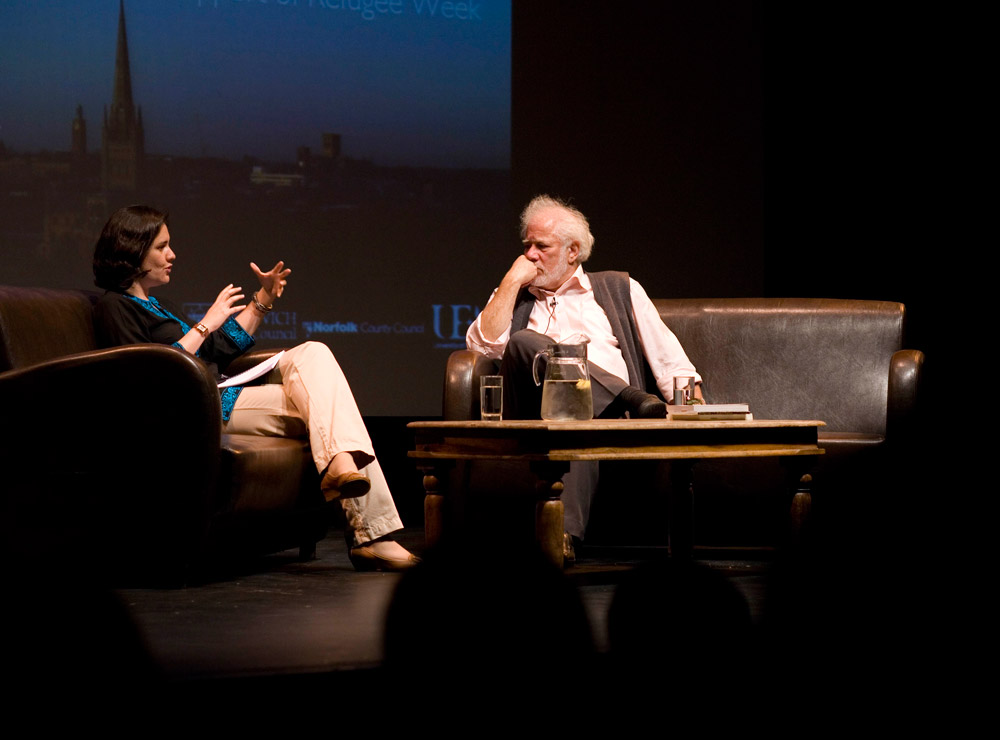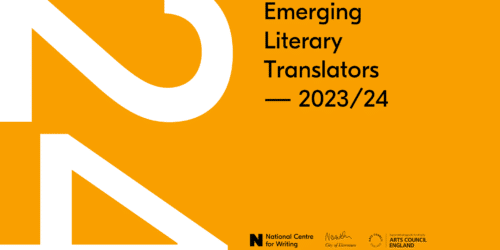
An original provocation by Kamila Shamsie for our event on women and publishing at the Hay Festival, 29th May
Several years ago at the Jaipur festival, Martin Amis chaired a panel on ‘The Crisis of American Fiction’ with Richard Ford, Jay Mcinnerney and Junot Diaz. I was in the audience, and halfway through the discussion leaned over to the person sitting next to me and said, ‘clearly the crisis of American fiction is that there are no women in it’. It’s not just that there weren’t any women on the stage. In the entire discussion, which lasted nearly an hour, there was no mention of Toni Morrison, Marilyn Robinson, Annie Proulx, Anne Tyler, Donna Tartt, Jhumpa Lahiri or any other contemporary woman writer. A single reference to Eudora Welty was in fact the only acknowledgement that women in America have ever had anything to do with the world of letters. Junot Diaz, near the end of the hour, made the point that the conversation had centred on White American males, but it was much too little, much too late.
I think of this panel when reading yet another article or survey about the gender imbalance that exists in publishing, in terms of reviews, top positions in publishing, literary prizes etc. I know the reason I had been struck by it was that it seemed to me less an anomaly than an extreme version of a too–prevalent attitude by men – including male writers – towards women writers. To clarify the matter, I thought it might be useful to do the very unwriterly thing of turning from narrative to statistics. Over the last five years, the Guardian has asked 252 cultural figures, almost all of them writers, for their year–end book recommendations. 162 among them listed one or more works of fiction. Of those, 56% of the men chose books written by men only as opposed to 32% of women who chose books by women only. And 15% of men chose books by women only, while 29% of women chose books by men only. If male writers are so much more likely than women writers to value books by their own gender, what does that mean for judging panels, for book blurbs, for the championing of lesser known writers by better–known writers? What, in short, does it mean for the literary culture in which we live?
While considering these matters, there’s one more set of figures that’s significant. Of the 252 people who picked their books of the year, only 37% were women. In the past when the issue of women’s representation in literary pages gets has been brought up it’s very often women editors who, while voicing their frustration with the situation, mention how much more likely men are than women to agree to review or judge or make lists of favourites. Suzi Feay, writing on the issue in 2011, discussed her own attempts to get writers to submit choices for a books of the year feature: ‘You’d think it would be a pretty easy ask: a nomination for a (not the) book of the year. Yet in the first fortnight, not one female author approached said yes, while virtually all the men did. They had no trouble believing their views were worth having.’ I asked Ginny Hooker from the Review whether the comparative reticence of women writers was the reason the Books of the Year contributors were mostly men. She said ‘We always try to get a balance, and although I don’t have accurate records, my sense was always that more women said no to contributing than men did. So I would definitely ask a lot more women than would eventually end up contributing. But I suspect that if you looked at the number of people I’ve approached, it would probably be more than 50% men – something to do with who is in the public eye.’ It’s a double bind then. More men than women get asked to judge, nominate, recommend – and of those who are asked, more men than women agree to do so, and those more men are more likely to recommend yet more men.
This is not to say that any experience within publishing can be broken down into a story of fair–minded women versus bigoted men. Like any effective system of power – and patriarchy is, over time and space, the world’s most effective system of power – the means of keeping the power structure intact is complex, and involves all parties. One area in which this complexity can be examined is via literary prizes – which carry increasing weight in a book’s chance of success in the world. As a snapshot, let’s look at the Man Booker prize over the last five years. Ever since the Women’s Prize for Fiction – formerly the Orange, now the Bailey’s – was set up 20 years ago in response to an all–male Booker shortlist, this has been the prize to which the most attention is paid in gender terms. If you were to look at the longlists, shortlists, and winners of the last 5 years there’s an easy conclusion: it’s gender biased. More men than women make up these lists. The casual observer might conclude that the judges have their patriarchal hats firmly on their heads when making their decisions. Except, the primary problem may not lie with the judges.
The question of the Man Booker prize judges and gender came up last year when only 3 women were on a longlist of 13. In response, one of the judges Sarah Churchwell said, ‘We read what publishers submit to us. . . [If] publishers only submit a fraction of women, then that is a function of systemic institutional sexism in our culture.’ So I asked the Man Booker administrators how many of the submitted books in the last 5 years have been written by women. The answer was, slightly under 40%. I should add, this isn’t an issue around the Booker alone. I’ve more than once been uncomfortable with the imbalance between male and female writers in terms of the books that get submitted for prizes that I’m judging. Because publisher submissions remain confidential this part of the equation remains uncommented on when judges are held to account for the gender imbalance of the long and short lists they produce.
In the 5 years in which slightly under 40% of the submitted books have been written by women, the percentage of women on the longlist has been slightly over 40%. The percentage of women on the shortlist has been 46%. The percentage of women to win the prize has been exactly 40%. In this period, although 4 out of 5 of the chairs of the Booker juries have been men, there’s been an almost even split of male and female jurors. The picture that starts to emerge from these statistics is one of judges who judge without gender bias but are hamstrung by polishers who submit with a strong tilt towards books by men. But, as is so often the case with statistics, there are other figures that complicate the story. In 2013, in a Guardian article, Debbie Taylor of Mslexia magazine pointed out that ‘of the last 10 books to win the Booker prize, eight had male protagonists, one a female protagonist, and one both male and female protagonists … If a woman adopts a male perspective, it seems their story is still more likely to be respected, and read as universal.’ It’s worth mentioning that the two books that have won the Man Booker since that interview was published – The Luminaries and The Narrow Road to the Deep North – both have male protagonists. Of course we don’t know how many of the submitted books had female protagonists, but it remains instructive to look, by contrast, at the books that have won the Baileys Women’s Prize – formerly the Orange, now the Baileys . In the last 12 years, 4 of the books have centred on a male protagonist, 3 on a female protagonist, and 5 on a mix of male and female protagonists. This, I would argue, is a consequence not only of having women-only submissions, but also of having women-only judges.
I could go on with the statistics and observations – the 64 male versus 36 female authors who make up the World Book Night picks of the last 5 years; the gendered decisions about how to package and describe male versus female authors; a recap of the VIDA statistics that show how much more space male writers and reviewers receive in literary publications on either side of the Atlantic. But at this that [‘this’?] point, I’m going to assume that the only people who really doubt that there’s a gender bias going on are those who stick with the idea that more men are better writers and better critics, and that when men recommend books by men that’s fair literary judgement while when women recommend books by women that’s either a political position or woolly feminine judgement. To these people I have nothing to say except, go away and improve yourself by reading some Toni Morrison.
The question isn’t ‘Is there a problem?’; it’s, ‘Are we recognising how deep it runs, and do we know what to do about it?’ The easy response is to always blame someone else. Prize judges can blame publishers who can blame the kinds of books that cut across male and female reading tastes. Literary editors can blame the women writers who don’t take up chances that are offered to them and the women writers can blame the editors who shift the blame rather than acknowledging they don’t ask as many women to begin with. We can all say, men don’t just have more confidence about picking their books of the year, they also have more confidence about writing big, bold novels – and then we can work out that ‘big and bold’ are only more appealing than ‘subtle and with emotional depth’ because literary cultures have historically been formed by men which allows a patriarchal view to look like a universal truth.
Well, enough. Across the board, enough. Let’s agree that things have improved over the last 50 years, even over the last 20, and then let’s start to ask why. Was it simply the passage of time? Should we all sit around while the world continues on its slow upward trend to a world of equality? Or should we step outside that fictional narrative and ask what actually helped to change literary culture in the UK? Two things come to mind: the literary presses of the 70s, of which Virago is the most notable; and the Women’s Prize for Fiction. I should add, I speak as someone whose great–aunt, Attia Hosein, was brought back into print after 3 decades by Virago Modern Classics, and also as someone who has been twice shortlisted for the Women’s Prize, and seen precisely how great an effect that has on a book. In part, what both the presses and the prize did was to create a space for women in a male–dominated world, giving voice and space to those who wouldn’t find them elsewhere. But they also brought questions of female exclusion or marginalisation into the conversation. VIDA, the literary organization which focuses on women in the literary arts, is doing the same with its annual gender breakdown of literary publications. And VIDA has also recognised that power privilege on either side of the Atlantic is not merely about gender but also about race – they now have an Annual Women of Colour Count too. That I’ve failed to mention race until now doesn’t mean I don’t recognise it as an even more lopsided and neglected matter than gender. What we need is more. Not more special privileges for women, but more ways of countering the special privileges doled out to white men.
Now that the problem has been recognised, analysed, translated into graphs and charts and statistics it is time for everyone, male and female, in our literary culture to sign up to a concerted campaign to redress the inequality for which we all sectors of the culture bear responsibility. Last year readers, critics and at least one literary journal signed up to a ’Year of Reading Women’ – or in the case of the journal ‘The Critical Flame’, a year of reading women writers and writers of colour. Let’s take it a step further – let’s have a Year of Publishing Women Writers and Writers of Colour. 2018 , the 100th anniversary of women getting the vote in the UK, seems both near enough and distant enough to be feasible. Of course there will be many details to work out – including, what happens to paperback of books published the prior year and can we find a more catchy name than Year of Publishing Women Writers and Writers of Colour (YPWWWC) – but the basic premise is precisely what it says on the tin. Of course the knock of effect of a Year of Publishing Women and Writers of Colour will be evident in review pages and blogs, in bookshop windows and front of store displays, in literary festival line-ups, in prize submissions. We must learn from the suffragettes that it’s not always necessary or helpful to be polite about our campaigns. If some publishing houses refuse to sign up, then it’s for the literary pages and booksellers and bloggers and literary festivals to say their commitment to YPWWWC means they won’t be able to give space to the white male writers who are being published that year. I’m not discounting the fact that many white male writers will, I’m sure, also back YPWWWC and refuse to submit their books for publication in the given year, while also taking an active part by reading, reviewing and recommending the books that are published.
What will it look like, this changed landscape of publishing in 2018? Actually, the real question is what will happen in 2019? Will we revert to status quo or will a year of a radically transformed publishing landscape change our expectations of what is normal and our pre-conceptions of which is unchangeable? I suggest we find out.
Kamila Shamsie is the author of six novels, including the 2015 Bailey’s Prize long-listed A God in Every Stone and Burnt Shadows, which has been translated into more than 20 languages and was shortlisted for the Orange Prize for Fiction. Three of her other novels (In the City by the Sea, Kartography, Broken Verses) have received awards from the Pakistan Academy of Letters. A Fellow of the Royal Society of Literature, and one of Granta’s ‘Best of Young British Novelists’, she grew up in Karachi, and now lives in London.
Find about more about the National Conversation debates and have your say.







